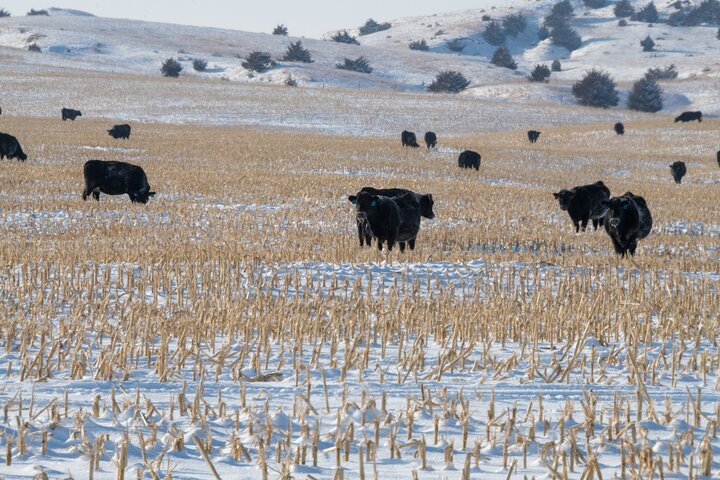Having cows graze to meet their nutrient needs is less expensive than having to deliver harvested forages to them. Crop residues can be an inexpensive option.
When grazing residue, cattle will select and eat the grain first, followed by the husk and leaf and finally the cob and stalk. Unless the corn field has experienced high winds causing a lot of corn to be left in the field, there is usually less than a bushel of ear drop per acre. If cows have husk and leaf to select, they will consume a diet that is 52 to 55 percent TDN and about 5% to 5.5% crude protein.
In the Midwest, weather records indicate the range in number of continuous grazing days for crop residue is 65-111 days. Weather is the major factor that determines the number of grazing days. Beef cows can successfully graze corn residue fields that have 4 to 6 inches of snow cover. Cows will not be able to graze stalk fields that are covered with ice.
Stocking rate influences the amount of grain, husk, and leaf available per animal. The amount of grain, leaf, and husk available affect diet quality because they are highly digestible. Residue (leaf and husk) yield left in the field is related to corn grain yield. There will be about 16 lb dry leaf and husk per bushel of corn yield.
We recommend designing a grazing strategy to remove only 50% of the leaf and husk. Instead of remembering this equation, there is a nice spreadsheet, Corn Stalk Grazing Calculator, that is available that will help you determine the number of acres at a specific corn grain yield needed for a certain number of cows. To run this spreadsheet, you will need Excel.
Ordinarily, dry cows will maintain body weight, and may gain weight, on corn and grain sorghum residue grazing programs when grain, husks, and leaves are available. Do not force cattle to eat the cobs and stalks.
UNL research data would suggest that March calving cows that were protein supplemented and those that were not protein supplemented grazing similar corn residue fields were similar in reproductive performance. Cows in both groups had a BCS greater than 5.0 prior to calving (2009 Nebraska Beef Cattle Report: Effect of Winter Grazing System and Supplementation on Beef Cow and Progeny Performance).
Cows were grazed from mid-November to about mid-February each year and stocking rate was determined using the grazing calculator mentioned above. Cows were about a BCS of 5 when they began the corn residue grazing period. Salt, mineral, and Vitamin A supplements are recommended for all cattle grazing crop residues.

